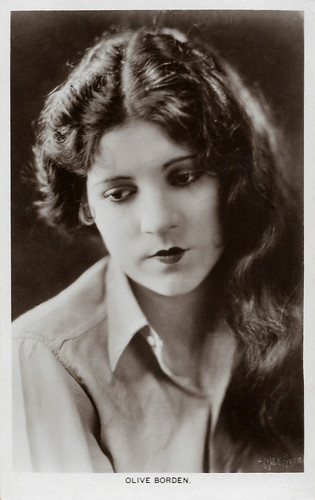
British postcard in the Picturegoer Series, London, no. 296. Photo: Max Munn Autrey.

Italian postcard by Casa Editrice Ballerini & Fratini, Firenze, no. 630. Photo: Fox Film Corp., Roma.
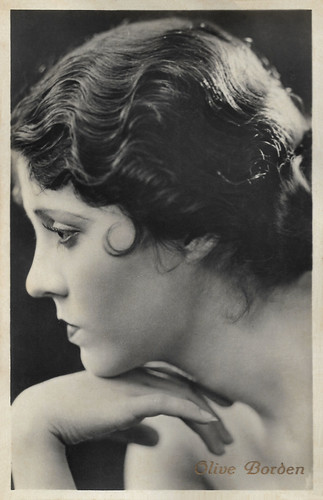
Italian postcard by G.B. Falci Editore, Milano, no. 543.
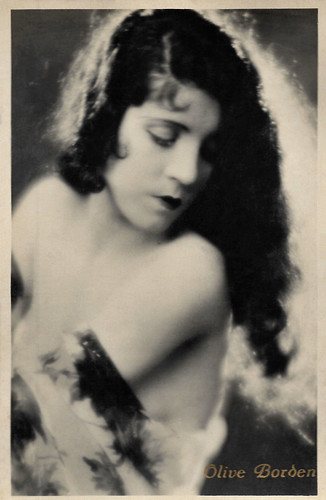
Italian postcard by G.B. Falci Editore, Milano, no. 614.

Italian postcard. Photo: Columbia Pictures. Olive Borden in Virgin Lips (Elmer Clifton, 1928). The postcard indicates the film as 1929, possibly the year it was released in Italy by the company EIA in Rome, under the title Labbra di vergine.
One of the Sennett Bathing Beauties
Olive Mary Borden was born in Richmond, Virginia in 1906. Contrary to urban legend, her original name was not Sybil Tinkle. Her father, Harry Robinson Borden, died when she was a baby and she was raised by her mother Cecilia Agnes Shields Borden.
As a teenager, she persuaded her widowed mother to take her to Hollywood to pursue a career in show business. To support themselves they opened a candy store and Olive worked as a telephone operator.
In 1922, Borden began her film career as one of the Sennett Bathing Beauties and was soon appearing as a vamp in Hal Roach comedy shorts. Producer Paul Bern chose her for an uncredited role in his film The Dressmaker from Paris (Paul Bern, 1925), starring Leatrice Joy Janiss Garza at AllMovie: "The flimsy plot to this romance seems to exist purely for the opportunity to have a fashion show in mid-picture. This is too bad, considering some of the names attached to the production: Howard Hawks was one of the writers, Paul Bern directed, and the whole production was overseen by Cecil B. DeMille."
Olive was signed by Fox after being named one of the 13 WAMPAS Baby Stars in 1925. Borden quickly became one of their most popular and highest-paid stars earning a salary of $1,500 a week and celebrated for her long pitch-black hair. She had starring roles in eleven films at Fox, including the classic Western 3 Bad Men (John Ford, 1926) and Fig Leaves (Howard Hawks, 1926), both of which co-starred her then-boyfriend, George O'Brien. Hal Erickson at AllMovie: "Fig Leaves is historically important as the earliest extant film of director Howard Hawks. A partial parody of the Cecil B. DeMille historical spectacles, the film opens in the Garden of Eden, where Adam (George O'Brien) tries to read his morning paper (a stone tablet, a la The Flintstones) while Eve (Olive Borden) complains that she has nothing to wear."
After her leading role in the playful The Joy Girl (Allan Dwan, 1927), she was nicknamed 'the Joy Girl'. Borden starred as impulsive flapper Jewel Courage, who dumps the man she loves, a humble chauffeur (Jimmy Grainger Jr.) in favour of millionaire John Jeffrey Fleet (Neil Hamilton). Hal Erickson: "the film's principal selling angle was the stunning beauty of Olive Borden, who appeared in a variety of revealing outfits." But soon Olive's career waned. Paramount Studios began a policy of 10% pay cuts on any salary over $50 to recoup production costs, when Fox tried the same and cut her salary in 1927, Borden left the studio. By this point, she was a major silent film star. In making the transition to 'talkies', she worked with a voice coach to suppress her Southern accent.
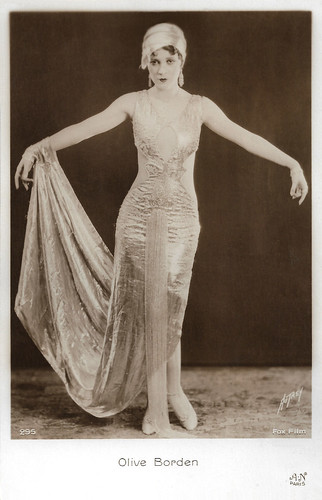
French postcard by A.N., Paris, no. 295. Photo: Max Munn Autrey / Fox.

Spanish postcard by EFB (Editorial Fotografica, Barcelona), no. A-45. Photo: Max Munn Autrey.
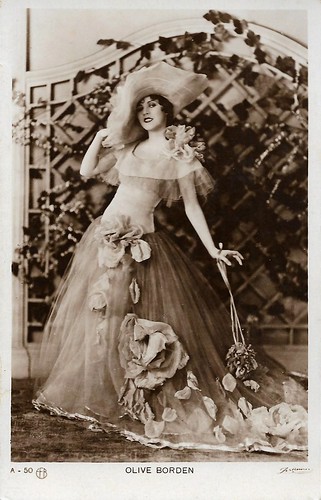
Spanish postcard by EFB (Editorial Fotografica, Barcelona), no. A-50. Photo: Zerkowitz.
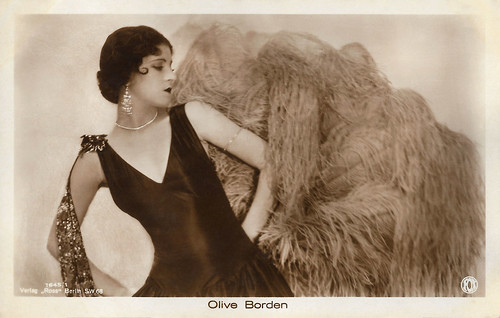
German postcard by Ross Verlag, Berlin, no. 1645/1, 1927-1928. Photo: Fox.

German postcard by Ross Verlag, Berlin, no. 1964/1, 1927-28. Photo: Max Munn Autrey / Fox.
A lavish lifestyle with limos, mansions, servants, and a dozen fur coats
Olive Borden lived a lavish lifestyle with limos, mansions, servants, and a dozen fur coats. By 1929, her career began to wane due to her rumoured reputation for being temperamental and her difficulty transitioning to sound films. She continued to work for Columbia and RKO. She had cut her trademark jet-black hair into a short bob and turned herself into a modern flapper. In Hello Sister (Walter Lang, 1930), produced and supervised by legendary silent-film director James Cruze, she starred as pert heiress Vee Newell who falls in love with handsome deacon Marshall Jones (Lloyd Hughes).
But Borden had trouble with the new look, losing her identity. She couldn't find her audience and this confused her waning public. Her strong Southern accent did not help. Frequently she had played Vamps, exotic types, and sophisticated society women, but those sorts of characters did not match the type of voice she had. In 1932, she appeared only in one feature, The Divorce Racket (Aubrey Scotto, 1932) starring James Rennie. In 1933 she made the British comedy Leave it to Me (Monty Banks, 1933) with Gene Gerrard, Hotel Variety (Raymond Cannon, 1933), and such shorts as The Mild West (Joseph Henabery, 1933).
Her last screen credit came in the low-budget film Chloe, Love Is Calling You (Marshall Neilan, 1934), where she played a woman kidnapped at birth and raised as a child of mixed race. Robert Firsching at AllMovie: "All the black characters despise white people, and even Mandy turns against the mulatto girl she raised, trying to cut her heart out in a voodoo ritual. As in many such efforts, 'whiteness' wins out in the end. This is a sad spectacle to behold today, but was par for the course in 1934." A pre-code movie made under Will Hays, it had little box office success and in some states (mostly southern) it was banned at the time of its release.
Olive made headlines in 1935 when she was named as the other woman in actor Ralph Emerson's divorce. She and Emerson costarred in Dance Hall (Melville W. Brown, 1929) and had an affair in 1934. When his wife, Jane N. Scholtz, found out, she filed for divorce and told the court that Emerson cheated on her with Borden. The bad publicity hurt Borden's reputation, and she never made another film.
Borden then moved to New York, where she had a brief stage career, and made a living on the waning vaudeville circuit. By the late 1930s, she was declared bankrupt and stopped acting. Borden then found work as a postal clerk and mail carrier and also worked as a nurse's aide. During World War II, she joined the Women's Army Corps. She served as an ambulance driver and received an Army citation for bravery in turning over an enemy ammunition truck. She was later honourably discharged with distinction after sustaining a severe foot injury during service.
Borden attempted a comeback in films, however, she was hindered by her alcoholism and health problems. In 1945, she began working at the Sunshine Mission, a home for impoverished women located in the skidrow section of Los Angeles. Olive Borden died there in a hotel room in October 1947 of a stomach ailment and pneumonia at the age of 41. A simple funeral was held at the Sunshine Mission for Women, where its founder, Pastor Essie Binkley West, performed the last rites, saying, "She played her greatest role when she became a star for Jesus." No one from her glory days in Hollywood was there, but a fairly large crowd came from the surrounding community of Skid Row. Sadly many of Borden's silent films have been lost.
Olive Borden was engaged to actor George O'Brien in 1929 and was also romantically involved with director Marshall Neilan. She was married twice. Her first marriage was to stockbroker Theodore Spector, whom she married in 1931. The marriage was rocky from the start, and the couple separated in early 1932 after news broke that she was involved in a love triangle. Spector had not divorced his first wife, Pearl, whom he married in 1919, and he was arrested for bigamy after his first wife came forward and claimed they were still married. In November 1932, Borden petitioned the court for an annulment, which was granted. Spector was ultimately cleared of bigamy, but Borden with the marriage annulled moved on from the entire incident. She married her second husband, 26-year-old railroad technician, John Moeller in 1934 under the pseudonym Mary Borden. That marriage ended in divorce seven years later.
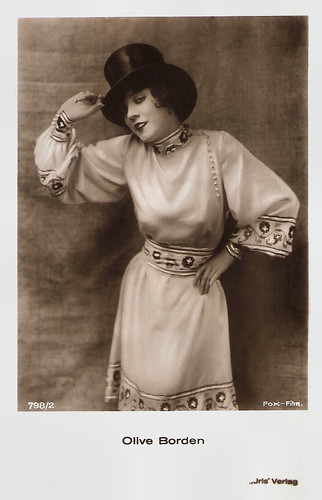
Austrian postcard by Iris Verlag, no. 798/2. Photo: Fox-Film.
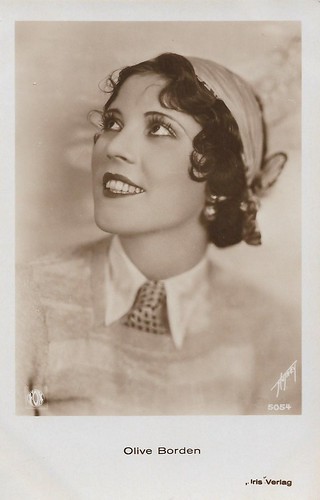
Austrian postcard by Iris Verlag, no. 5054. Photo: Max Munn Autrey / Fox.
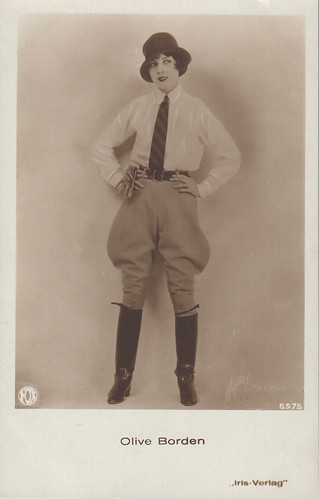
Austrian postcard by Iris Verlag, no. 6575. Photo: Max Munn Autrey / Fox. Collection: Marlene Pilaete.

German postcard by Ross Verlag, no. 3195/1, 1928-29. Photo: Fox.

Vintage postcard, no. 220.
Sources: Janiss Garza (AllMovie), Robert Firsching (AllMovie), Hal Erickson (AllMovie), Carrie-Anne (Finf-A-Grave), Wikipedia and IMDb.
No comments:
Post a Comment